2025 Marketing Budget: Insights from 11,000+ CMOs
As we navigate through 2025, marketing leaders face unprecedented budget allocation challenges amid economic uncertainty, technological disruption, and evolving consumer behaviors. The latest CMO Survey, drawing insights from over 11,000 marketing executives, reveals critical trends shaping marketing budget decisions this year. This comprehensive analysis explores how marketing budgets are evolving, where top CMOs are investing, and how to optimize your marketing spend to drive maximum ROI in today’s complex landscape.
Key Takeaways
- Marketing budgets now represent 9.4% of company revenues and 11.4% of overall company budgets—significant increases from 7.7% and 10.1% in 2024
- Digital marketing spending continues to rise, with projected growth of 11.9% by 2026
- AI integration in marketing has doubled since 2022, now powering 17.2% of marketing efforts with projected growth to 44.2% within three years
- Creator marketing is surging, with 92% of brands planning to increase their spending on creators in 2025
- Marketing leaders face increased pressure to demonstrate ROI, with 63% reporting heightened scrutiny from CFOs
- Social media spending shows consistent pattern of unrealized projections, currently at 11.3% of marketing budgets
- Marketing teams are evolving, with full-time employees now representing 77.9% of expected hires—down from 82.5% in 2019
TABLE OF CONTENTS:
The State of Marketing Budgets in 2025
Budget Growth Trends
The 34th edition of The CMO Survey reveals a complex landscape for marketing budgets in 2025. Despite economic headwinds, marketing budgets have grown to represent 9.4% of company revenues and 11.4% of overall company budgets—significant increases from 7.7% and 10.1% in 2024, respectively.
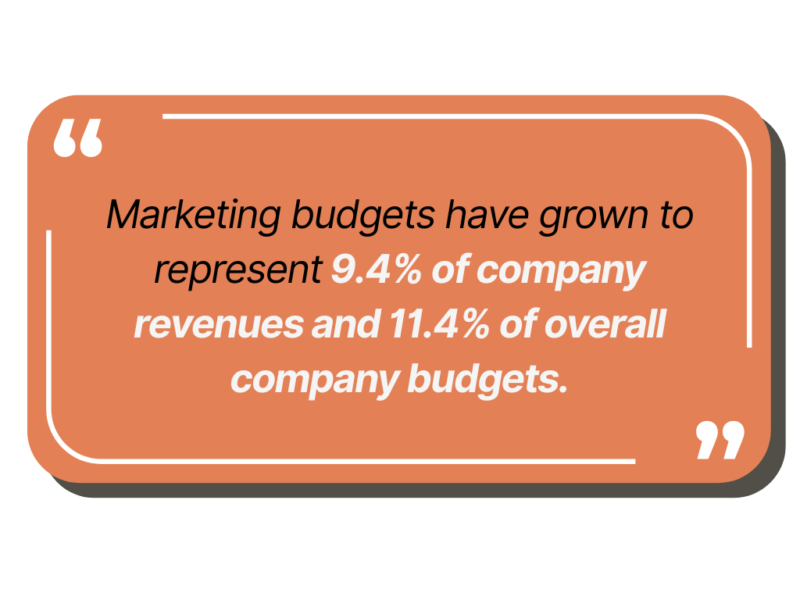
However, the rate of budget growth has slowed considerably. Marketing budgets grew annually by 3.3%, down from the 5.8% annual increase recorded in Fall 2024. Digital marketing spending increased by 7.3%, a notable decrease from the 11.1% growth reported previously.
This paradoxical situation—where marketing’s share of overall budgets is increasing while growth rates are declining—suggests that company revenues and overall budgets are growing even more slowly than marketing budgets.
Industry Variations
Marketing budget allocations vary significantly across industries:

Service-oriented businesses, particularly in the B2C sector, continue allocating a larger budget share to marketing than product-focused companies.
Future Projections
Looking ahead to 2026, marketing leaders forecast stronger budget growth:
- 8.9% for overall marketing spending
- 11.9% for digital marketing initiatives
Cautiously consider these optimistic projections. As the CMO Survey notes, similar projections in previous years have consistently failed to materialize, particularly in areas like social media spending.
Where CMOs Are Investing in 2025
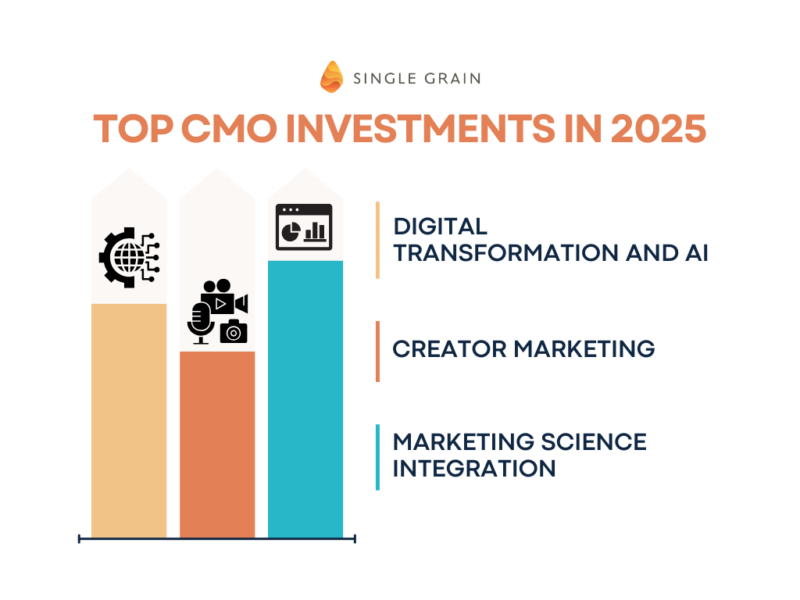
Digital Transformation and AI
AI’s integration in marketing operations continues to accelerate, powering 17.2% of marketing efforts—a remarkable 100% increase since 2022. Marketing leaders project this integration will reach 44.2% within three years.
Generative AI adoption has surged 116% year-over-year, now deployed across 15.1% of marketing activities compared to just 7.0% a year ago. This investment is delivering tangible results:
- 8.6% improvement in sales productivity (up from 5.1% in Spring 2024)
- 8.5% increase in customer satisfaction (up from 6.1%)
- 10.8% reduction in marketing overhead costs (versus 7.0% previously)
“AI is no longer just a buzzword in marketing—it’s becoming the backbone of efficient, data-driven operations,” notes Jane Irene Kelly, a marketing budget analyst. “CMOs who aren’t allocating significant resources to AI implementation risk falling behind competitors who are seeing real returns on these investments.”
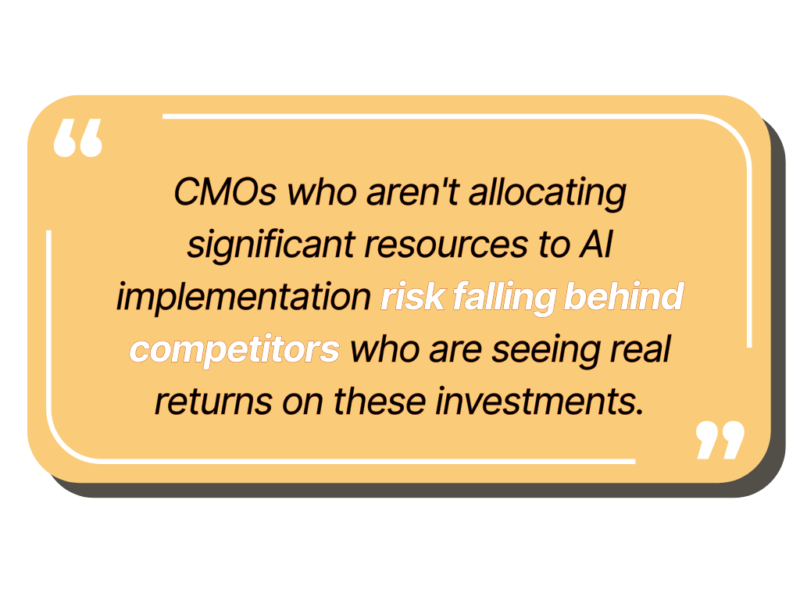
Creator Marketing
Creator marketing has emerged as a major budget priority for 2025. According to industry research, 92% of brands plan to increase their spending on creators this year, with 36% intending to allocate at least half their digital marketing budget to creator partnerships.
The biggest challenge for brands is finding the right content creator partnerships, a time-consuming and potentially risky process. Successful brands are focusing on aligning with creators with shared values who have deep knowledge of target audiences rather than simply chasing those with the largest followings.
Single Grain’s paid advertising experts can help you identify and partner with the right creators to maximize your marketing ROI.
Marketing Science Integration
Data analytics has emerged as the top marketing investment priority for companies in 2025. CMOs are increasingly focused on integrating marketing science—using data and research to better understand customer needs and behaviors—into their strategic decision-making.
Key tools being deployed include:
- Advanced data analytics
- Customer segmentation
- Predictive analytics
- Descriptive analytics
- Sentiment analysis
- Cross-channel integration
This data-driven approach allows marketing leaders to make more informed decisions and allocate their budgets more effectively across different channels, ensuring maximum return on investment.
Budget Allocation Strategies
Channel Distribution
The CMO Survey reveals significant shifts in how marketing budgets are being distributed across channels:
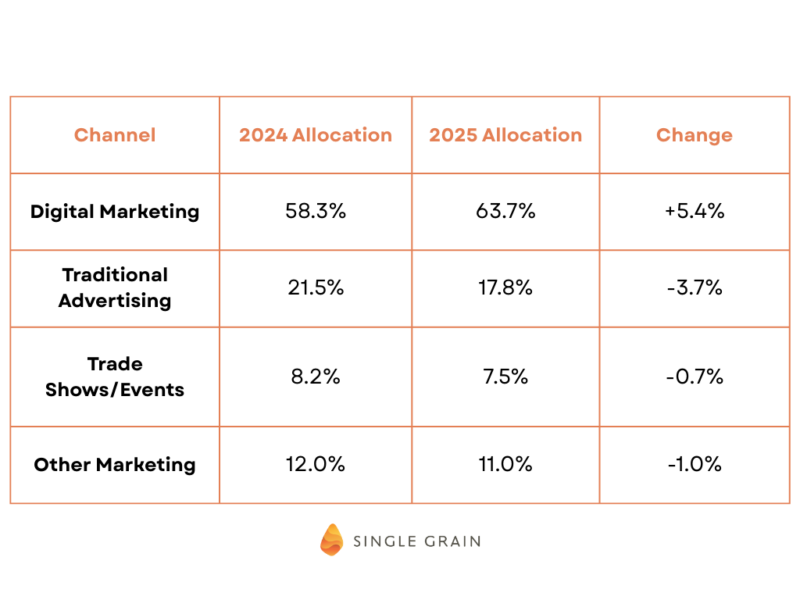
Digital marketing continues to claim an increasing share of marketing budgets, with traditional advertising seeing the most significant decline. Within digital marketing, social media (11.3% of total marketing budget), content marketing (10.2%), and paid search (9.8%) receive the largest allocations.
Talent and Team Structure
Marketing organizations expanded headcount by 5.4% in 2024, with similar growth projected for 2025. However, the composition of marketing teams continues to evolve, with full-time employees now representing 77.9% of expected hires—down from 82.5% in 2019.
This shift reflects increasing reliance on:
- Full-time contractors (7.8%, up from 5.4% in 2019)
- Part-time contractors (9.9%, up from 9.0%)
- Part-time employees (4.4%, up from 3.1%)
“Hiring top talent” represents marketing leaders’ most significant people challenge, followed by “identifying best candidates,” “retention,” and “training.” Primary hiring obstacles include inadequate compensation, difficulty finding specialized expertise, and talent scarcity.
Social Media Investment Reality Check
Social media investments decreased to 11.3% of marketing budgets (from 12.1% in Fall 2024), though leaders project increases to 13.3% within 12 months and 18.4% within five years.
However, these optimistic projections follow a decade-long pattern that has consistently failed to materialize:
- Spring 2024 projections called for 12.2% social media spending within a year (actual: 11.3%)
- Spring 2023 projections anticipated 20.3% social media spending within a year (actual: 11%)
This pattern suggests that marketing leaders should approach social media budget projections with caution and focus on measurable returns rather than following industry hype.
Economic Factors Influencing Marketing Budgets
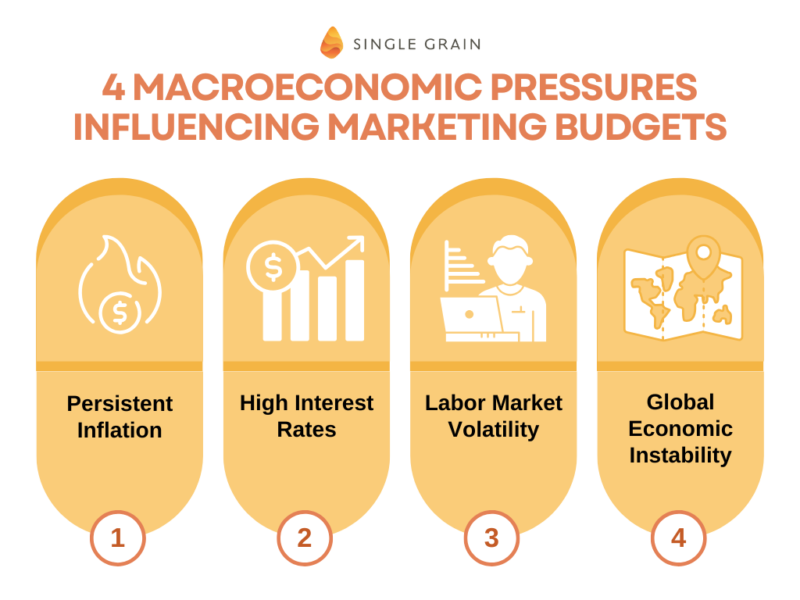
Macroeconomic Pressures
Marketing leaders express declining optimism about economic conditions, with nearly half reporting they are “less optimistic” about the U.S. economy compared to the previous quarter. Several factors are contributing to this cautious outlook:
- Persistent Inflation: While inflation has slowed, it continues to run high, affecting both consumer purchasing power and business costs.
- High Interest Rates: Interest rates remain at their highest levels in two decades, limiting cash flow for businesses and making it harder to borrow for marketing investments.
- Labor Market Volatility: Despite job growth in sectors like healthcare and retail, the tech sector has seen significant layoffs, creating uncertainty in talent acquisition and retention.
- Global Economic Instability: Economic challenges in major markets like Japan and China are creating ripple effects throughout the global economy.
These macroeconomic pressures are forcing marketing leaders to be more strategic and selective in their budget allocations, focusing on initiatives that can demonstrate clear ROI.
Performance Metrics Under Pressure
Key performance indicators reflect the challenging economic environment:
- Corporate sales growth fell to 8.3%, continuing a two-year decline from 14.1% in 2022.
- Profit growth showed modest improvement to 7.8% (from 7.4% in 2024), but remains below the 2022 peak of 10.7%.
- Customer retention and brand value metrics hit two-year lows.
- Customer acquisition showed slight improvement as the only bright spot.
These performance challenges are intensifying scrutiny on marketing budgets, with 63% of marketing leaders reporting increased pressure from CFOs (up from 52%), 61% facing greater scrutiny from CEOs (up from 51%), and 50% experiencing more pressure from Board members (up from 33%).
Strategic Budget Optimization Techniques
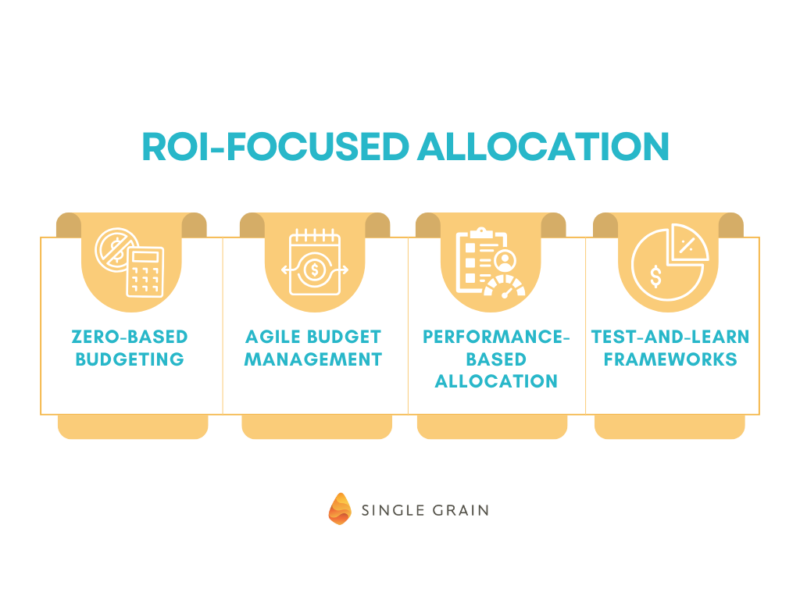
ROI-Focused Allocation
With increased pressure to demonstrate impact on financial outcomes, marketing leaders are adopting more sophisticated approaches to budget allocation:
- Zero-Based Budgeting: Rather than building on previous year’s budgets, some CMOs are adopting zero-based approaches that require justification for every dollar spent.
- Agile Budget Management: Implementing more flexible budget structures that allow for rapid reallocation based on performance data.
- Performance-Based Allocation: Shifting resources toward channels and campaigns that demonstrate the strongest returns.
- Test-and-Learn Frameworks: Dedicating portions of the budget to controlled experiments that can inform larger investments.
Single Grain’s content marketing team specializes in developing ROI-focused content strategies that deliver measurable results.
Cross-Functional Alignment
The CMO Survey reveals that marketing and C-suite colleagues align on “innovation,” “growth,” and “profitability” as key objectives, but misalignment persists in other areas. Marketing leaders place greater emphasis on “defending market position” and “investing in talent/capabilities,” while other executives prioritize “attracting investors and business partners.”
To address these gaps and secure budget approval, successful CMOs are:
- Speaking the Language of Finance: Framing marketing initiatives in terms of financial outcomes rather than marketing metrics.
- Collaborating Across Departments: Working closely with finance, sales, and product teams to develop integrated strategies.
- Implementing Shared KPIs: Establishing performance indicators that align marketing goals with broader business objectives.
- Improving Data Transparency: Providing real-time access to marketing performance data for key stakeholders.
Cross-functional collaboration continues to improve, particularly with finance and human resources departments in brand-building initiatives.
Emerging Budget Trends to Watch
Environmental and Social Responsibility
Despite economic pressures, marketing budgets for environmental and social initiatives remain resilient. The CMO Survey reports that companies are allocating an average of 8.3% of their marketing budgets to environmental sustainability initiatives and 7.9% to diversity, equity, and inclusion efforts.
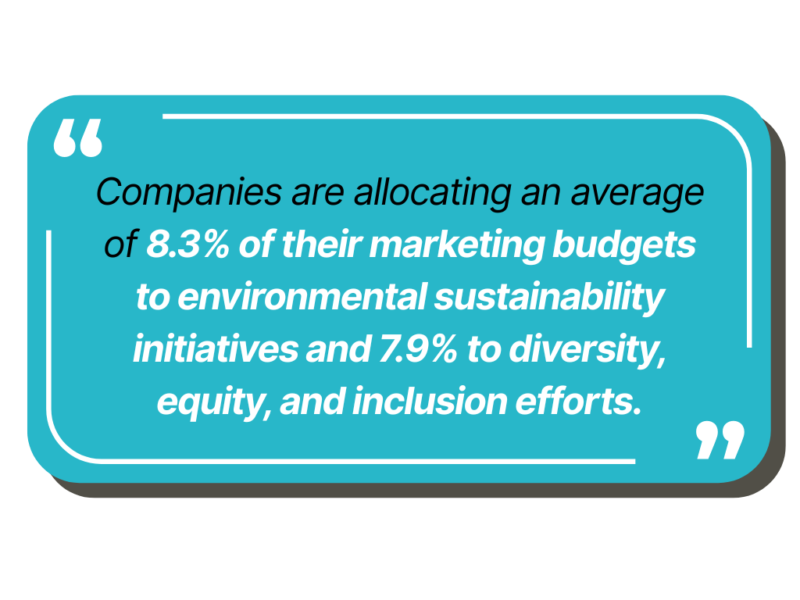
These investments reflect growing recognition that consumers increasingly factor corporate responsibility into their purchasing decisions. Brands that authentically communicate their values and commitments are seeing stronger customer loyalty and brand affinity.
First-Party Data Investments
With the continued deprecation of third-party cookies and increasing privacy regulations, CMOs are allocating significant resources to first-party data collection and activation. Investments in customer data platforms (CDPs), loyalty programs, and direct customer engagement initiatives are growing as brands seek to build direct relationships with consumers.
According to the CMO Survey, companies are allocating an average of 11.2% of their digital marketing budgets to first-party data initiatives, with this figure expected to reach 15.8% by 2026.
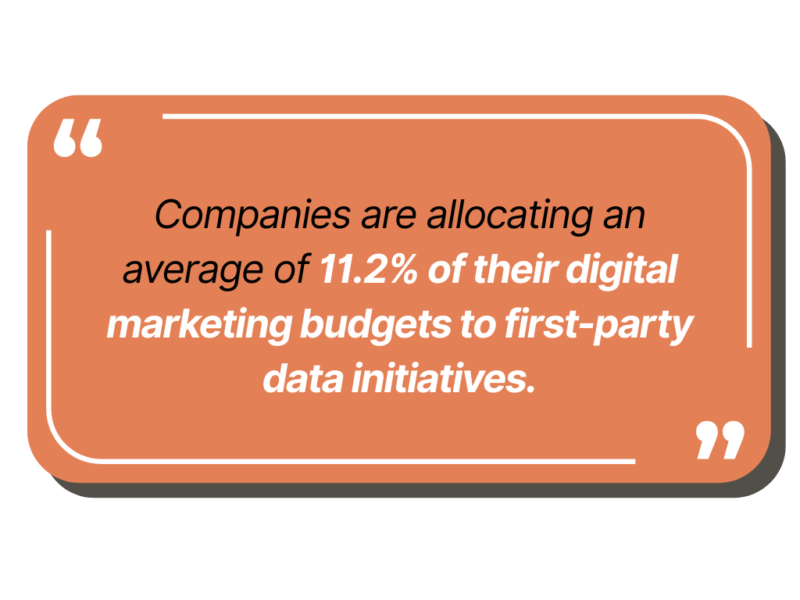
Experiential Marketing Resurgence
After years of digital acceleration, in-person experiences are making a comeback in marketing budgets. The CMO Survey reports that spending on experiential marketing is projected to grow by 6.7% in 2025, reflecting consumer desire for authentic, immersive brand interactions.
This trend is particularly pronounced in B2C sectors, where brands are creating hybrid experiences that blend physical and digital elements to engage consumers across multiple touchpoints.
Practical Budget Planning Framework for 2025
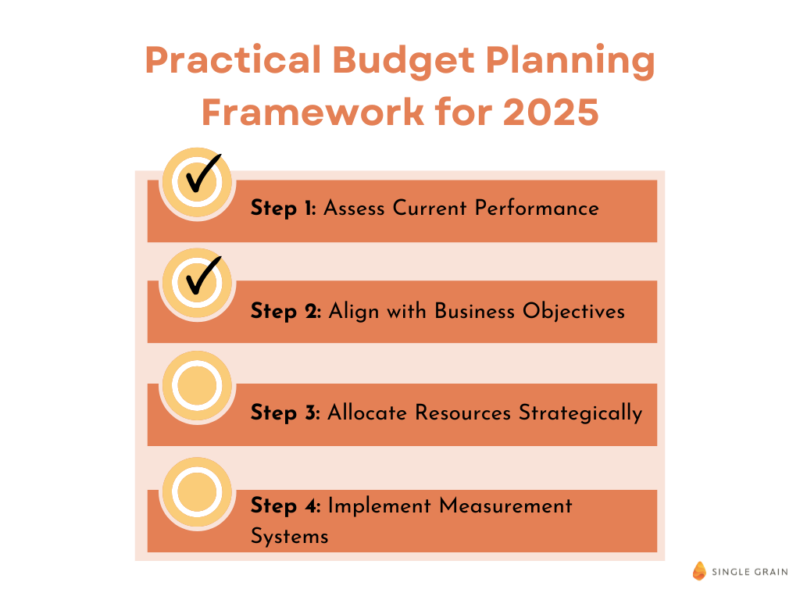
Step 1: Assess Current Performance
Begin by evaluating the performance of your existing marketing initiatives:
- Analyze ROI across channels and campaigns
- Identify high-performing and underperforming areas
- Benchmark your performance against industry standards
- Gather feedback from customers and stakeholders
This assessment provides the foundation for data-driven budget decisions.
Step 2: Align with Business Objectives
Ensure your marketing budget supports broader business goals:
- Identify key business objectives for the coming year
- Determine how marketing can contribute to each objective
- Establish clear, measurable marketing goals
- Secure buy-in from executive leadership
This alignment is critical for defending budget requests and demonstrating marketing’s strategic value.
Step 3: Allocate Resources Strategically
Based on your assessment and objectives, develop a strategic allocation plan:
- Prioritize initiatives with proven ROI or strategic importance
- Balance maintenance activities with growth investments
- Reserve budget for testing and innovation
- Build in flexibility to adapt to changing conditions
The CMO Survey suggests that high-performing companies typically allocate 70% of their budget to proven tactics, 20% to promising new approaches, and 10% to experimental initiatives.
Step 4: Implement Measurement Systems
Establish robust systems for tracking performance and ROI:
- Define clear KPIs for each initiative
- Implement attribution models appropriate to your business
- Create regular reporting cadences
- Develop protocols for budget adjustments based on performance
These measurement systems not only optimize current spending but also build credibility for future budget requests.
Single Grain’s SEO services include comprehensive measurement frameworks that help you track and optimize your marketing ROI.
Navigating Budget Complexity in 2025
The 2025 marketing landscape presents both challenges and opportunities for CMOs and marketing leaders. While economic pressures and increased scrutiny create budget constraints, technological advancements and evolving consumer behaviors open new avenues for engagement and growth.
Successful marketing leaders will approach budget planning with a balance of discipline and innovation—focusing resources on proven performers while continuing to explore emerging channels and technologies. By grounding budget decisions in data, aligning with business objectives, and maintaining flexibility to adapt to changing conditions, marketers can maximize the impact of their investments in this complex environment.
As the CMO Survey demonstrates, marketing’s strategic influence continues to grow despite these challenges. By embracing this expanded role and demonstrating clear connections between marketing investments and business outcomes, CMOs can secure the resources needed to drive growth and build lasting competitive advantage.
For organizations seeking to optimize their marketing budget allocation and maximize ROI, Single Grain’s paid advertising services offer data-driven strategies tailored to your specific business objectives and market conditions.
Related Video
2025 Marketing Budget FAQs
-
What are the 2025 marketing budget benchmarks by industry?
Here’s a practical baseline: 9.4% of revenue and 11.4% of overall company budgets, per The CMO Survey. Service-oriented B2C firms typically allocate more than product-led businesses. Use sector peers as your reference point, then apply zero-based budgeting, customer segmentation insights, and predictive analytics to tune channel mix and ROI expectations for your model.
-
How should I approach marketing budget allocation in 2025 to defend ROI?
Start with performance clarity: fund channels that consistently return measurable revenue. In 2025, The CMO Survey shows social at 11.3% of marketing budgets, content at 10.2%, and paid search at 9.8%. Use zero-based budgeting, agile budget management, and test-and-learn experiments to reallocate quickly based on incrementality, not hype. Align KPIs with finance.
-
According to the CMO Survey 2025, what should we expect from digital marketing budget 2025 growth?
Bottom line: expect steady but realistic gains. Digital marketing spending recently grew 7.3% and is forecast to rise 11.9% by 2026. Historically, projections—especially for social media spending—overrun reality, so build agile budgets and scenario plans. Use predictive analytics and sentiment analysis to prioritize content marketing, paid search, and creator programs that show durable ROI.
-
Are social media spending projections in the 2025 marketing budget realistic?
Short answer: be cautious. Actual social media spending sits at 11.3% of marketing budgets, and year-ahead projections have missed repeatedly. Treat forecasts as hypotheses. Run test-and-learn experiments, evaluate incremental lift, and anchor decisions in customer segmentation and attribution—not trend cycles. If results lag, reallocate to content marketing or paid search where ROI is clearer.
-
How to allocate marketing budget 2025 between content marketing, paid search, and creator partnerships?
Use the survey’s channel baselines as guardrails, not gospel: content marketing around 10.2%, paid search 9.8%, social 11.3%. With 92% of brands increasing creator marketing and 36% planning to devote half of their digital spend, pilot creators via performance contracts. Blend predictive analytics and sentiment analysis to match creators to segments and optimize ROI. Need a quick channel-mix audit? Single Grain can pressure-test it.
-
What 2025 marketing budget insights help justify spend to CFOs?
Lead with financial outcomes. Here’s what lands with finance: The CMO Survey shows marketing at 9.4% of revenue and 11.4% of company budgets. AI usage now powers 17.2% of efforts and correlates with 8.6% higher sales productivity, 8.5% better satisfaction, and 10.8% lower overhead. Tie requests to performance-based allocation, payback periods, and shared KPIs.
-
How big should my 2025 marketing budget be as a percent of revenue?
Here’s a reasonable starting point: 9.4% of revenue, per The CMO Survey. Adjust up for B2C services and growth-stage priorities, and down for mature, product-led models. Use zero-based budgeting and scenario planning to translate growth targets into channel investments across content, paid search, and social with clear ROI thresholds.
-
Where does generative AI fit in marketing budget allocation for 2025?
Don’t boil the ocean: fund AI where it moves the needle. Generative AI adoption has surged 116% year-over-year to 15.1% of activities, and broader AI powers 17.2% of marketing efforts with clear gains in productivity, satisfaction, and cost. Prioritize revenue-tied use cases—predictive analytics, personalization, automation—then scale via test-and-learn pilots and agile budget management.
-
What are the biggest marketing budget trends 2025 for B2B vs. B2C?
Here’s the gist: the direction is similar, but weightings differ. Both lean into digital transformation, analytics, and first-party data. B2C services typically allocate a larger budget share and are earlier on creator marketing. B2B leans harder on content marketing and paid search for measurable pipeline. In both cases, use performance-based allocation and CFO-aligned metrics.
-
How do I build an agile, zero-based digital marketing budget 2025 that adapts fast?
Start at zero with business cases linked to revenue goals, not last year’s spend. Set initial guardrails from The CMO Survey (social 11.3%, content 10.2%, paid search 9.8%), then run monthly test-and-learn cycles. Reallocate based on incremental ROI signals from attribution, sentiment analysis, and cohort models. Document decisions with finance. Want a faster rollout? Single Grain can set up the cadence.




